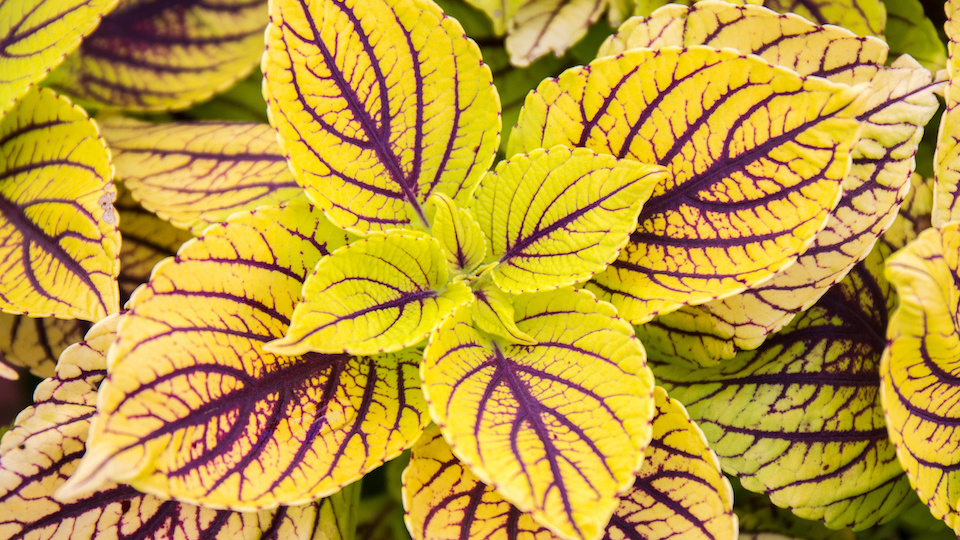Anyone who has some shady spots in their garden should consider the elegant coleus plant. Coleus was first made popular when it was used as a Victorian bedding plant. This sophisticated beauty has been making a comeback and is equally content in both traditional and modern gardens alike. These stunning plants give all-season color in the shade and are extremely easy to care for. Here are some tips for growing healthy coleus plants.
It is first important to know that coleus are tropical plants that are grown as annuals everywhere except USDA growing zone 11. However, they are fast-growing annuals, look great in containers, and can also be grown as an indoor houseplant, which makes them an excellent addition to your collection.
Starting seeds, transplanting and soil
Although old fashioned coleus can be grown from seed, many new varieties are started from cuttings. When growing from seed, start indoors about eight to ten weeks before your last predicted frost date. If you are growing coleus for a houseplant, you can start seeds anytime.
Because coleus are tropical in nature, it is essential not to rush planting outdoors if the weather is fickle. Be patient and wait until outdoor temperatures are holding at 60 degrees F before you move them into your garden. One little cold snap can kill plants quickly.
Coleus plants prefer soil with a neutral to slightly alkaline pH. Adding some organic matter to your soil will also help your coleus thrive.
Sunshine requirements
As mentioned, coleus plants love the shade. However, the best light exposure varies somewhat depending on the variety that you choose. Old fashioned, seed grown coleus like partial shade, but the newer, vegetatively cultivated types show their best color when they are grown in full sun. It also depends on which growing zone you are in. If you live in a hot and dry area, all coleus plants will appreciate some shade, especially from the hot afternoon sun. If you live in a cooler region with a shorter growing season, provide more sun exposure for your coleus plants.
Watering
The tropical nature of the coleus plant means it loves heat and moisture. Do not provide so much moisture that the soil is always wet, but be sure that you are providing enough moisture so that your plants do not have to endure long dry spells. When this happens, growth will slow and the edges of your plants will turn brown. Remember, coleus plants in containers require more water than those planted in the ground – even as much as twice a day if you live in a hot and dry region.
Mulching around plants will help retain moisture but do not use cedar mulch as it can be toxic to coleus plants. Do not allow mulch to touch the stems of plants as it can cause rot and draw slugs, which will damage plants.
Feeding
For best results, use a balanced fertilizer at half strength once a month. Overdoing the fertilizer will dull leaf color.
Pest and problems
The most significant pest issues you may have to deal with are groundhogs and baby rabbits who love to snack on young coleus plants. If these are common to your area, you should protect young plants as best you can early in the season. There are not many disease issues with coleus plants unless the weather becomes chilly and damp. Plants that are exposed to cold and damp weather may develop fungal diseases, including mildew. If you bring outdoor plants inside, check them first for scale, whiteflies, and mealybugs.
Overwintering
Coleus plants will become mush after the first frost hits. The good news is that you can save coleus plants over the winter. You have a couple of options when it comes to overwintering your coleus plants. The first option is to dig up the entire plant, pot it, and bring it indoors to grow as a houseplant during the winter. Be sure to place it in a sunny window and provide ample moisture. The second option is to take cuttings and grow smaller plants indoors or in a greenhouse for the next gardening season.
Using coleus plants in your garden
Their bright colors and exciting design patterns on their leaves make coleus a favorite in any garden setting. Coleus looks great when planted in groups or used as a border or as part of a larger container planting arrangement. I have used coleus plants around my mailbox, to line a walkway, and to encircle a pond. They really are lovely and seem to be right at home, no matter where you plant them.
Are you ready to try coleus plants in your garden?
-Susan Patterson



